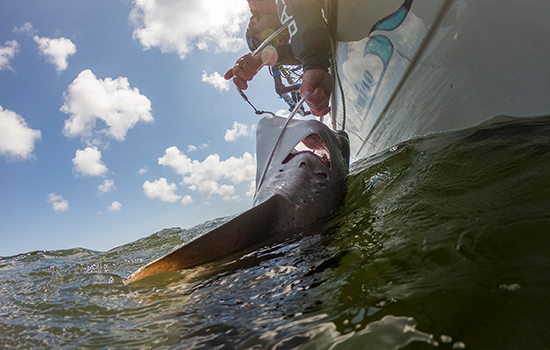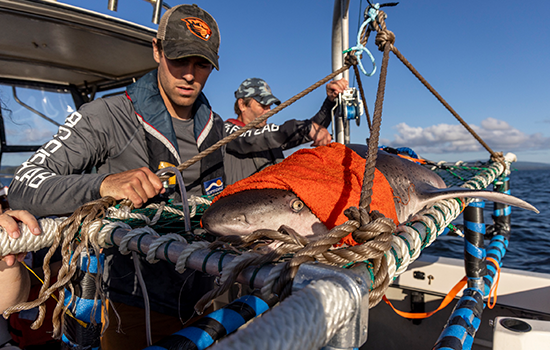Fear in the water
OSU researchers are working to change sharks’ reputation and replace our ignorance with awe.
By Cathleen Hockman-Wert
Photos by Louise Johns
“I felt it pulling a little bit. Then I saw the body and I’m like, ‘Oh my god.’”
Oceanography sophomore Gabriel Jurado has caught the day’s first shark. And it’s about to come aboard.
July 23, 7:13 p.m.: On the 22-foot Oregon State University research boat Arima, two graduate students, two undergrads and Assistant Professor Taylor Chapple are fishing for sharks in Willapa Bay, Washington. Coincidentally, it’s the first day of the Discovery Channel’s Shark Week.
Gabriel Jurado was one of five Indigenous students participating in the research trip with support from the Marine Studies Initiative.
The Northeast Pacific is home to at least 15 species of sharks, but we know relatively little about them. Chapple’s Big Fish Lab is aiming to change that — and to change attitudes among the world’s most dangerous species: the human race.
This day trip is for Jessica Schulte’s doctoral dissertation in fisheries science. She’s studying broadnose sevengill sharks (Notorynchus cepedianus). The goal is to learn where they go and what they eat. We can’t protect sharks when we don’t know the crucial habitats where they mate and give birth to their pups. When we don’t know how many there are, we can’t know if the population is stable or endangered. The Oregon Coast Aquarium has the conservation status for sevengill sharks listed as “unknown,” for lack of data.
“I felt it pulling a little bit. Then I saw the body and I’m like, ‘Oh my God.’”
Guided by a sonar depth finder, we drop four red buoys at the “honey hole”: an underwater crossroads where deep channels cut through the shallow, muddy bay. Each buoy has a weight that sinks to the bottom, plus hooks, each the size of a half-dollar. Sockeye salmon is the bait.
For the first hour, we catch eelgrass and a crab. “Is it time for Johnny Cash yet?” someone asks. Rumor has it, playing the Man in Black seems to draw the sharks. We throw a sacrificial Dorito overboard. Sturgeon jump.
Then Jurado feels that tug on the line.
“If it starts freaking out, just let go,” Chapple tells the student. Then he tells the shark: “Chill out, relax.” There’s a splash and a whump as a muscular gray body hits the boat.
Wrangling a hooked shark.
Raised in Ohio on the shores of Lake Erie, Chapple was just 13 when he earned his scuba certification. On a dive during a family vacation in Florida, he encountered his first shark: an eight-foot nurse shark lunching on a fish. With the last gulp, the shark swam past the youth: “a moment of sheer joy and sheer terror all at once.”
By now, Chapple has studied sharks — particularly great whites — for more than 20 years in the Indian, Atlantic and Pacific oceans. A College of Agricultural Sciences faculty member since 2019, based in the new Gladys Valley Marine Studies Building at OSU’s Hatfield Marine Science Center in Newport, Oregon, he typically spends 120 days per year on the water. But catching sight of those swift, powerful animals never grows old.
"I always tell people: if you've been in the ocean, you've been with a shark."
The boat tips to starboard as Chapple lowers a stretcher-like “cradle” into the water and works with master’s student Ethan Personius to maneuver the thrashing shark, its mouth gaping open with razor-sharp teeth. They secure the shark with three straps then crank a winch, lifting the cradle and swinging it around to straddle the back of the boat.
Sharks move up and down the Pacific Coast, many species arriving alongside Oregon and Washington in spring and returning south in the fall. Broadnose sevengills — so named because most sharks have five — seem to time their seasonal appearance with salmon, but we don’t know much about what they’re doing here.
Understanding sharks is important because as OSU ecologist Bill Ripple, Ph.D. ’84, has shown in his studies of wolves, apex predators — the eaters at the top of the food chain — play a key role in maintaining healthy ecosystems. If we want healthy, harvestable fisheries — think salmon, halibut, tuna, rockfish and Dungeness crab (and their cultural and economic value) — we need to understand the sharks that keep marine systems balanced. Even seagrass and coral reefs depend, indirectly, on sharks.
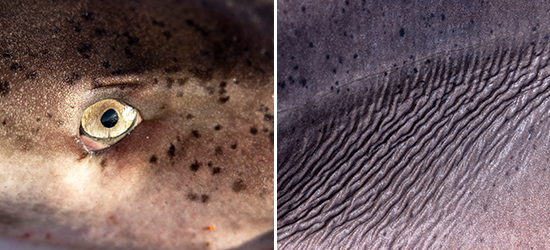
Moving quickly and carefully, Schulte inserts a PVC pipe into the shark’s mouth and aims a hose of water so it’s flowing over the gills, allowing the shark to breathe. To reduce the animal’s stress, she covers its lidless eyes with a small wet towel. Jurado steps in to hold the head and hose, while Schulte grabs the tape measure. The second undergrad, Ester Alexander, records the data.
This shark, a female, is seven feet and four inches long, about three feet around and 145 pounds: on the medium-large side for this species.
Sharks are big fish with a big, big PR problem.
They aren’t cute like otters or seals. They don’t do jumping tricks like dolphins. Even orcas — another apex predator — are glorious to watch, and they’ve got Free Willie. Sharks — consistently portrayed as giant eating machines, mindless killers or even savage megalodon attackers — got the devastation wreaked by Jaws.
“If sharks wanted to eat us, we’d be easy pickings."
Chapple is wary enough of media sensationalism that when invited to appear on Snoop Dogg’s “Sharkadelic Summer,” he declined. He notes that many so-called attacks can be ascribed to curiosity. Lacking hands, a shark has only one toothy way to grab something and check it out.
Generally, they aren’t interested in us. “If sharks wanted to eat us, we’d be easy pickings. There would be a lot fewer of us around. No one would go in the water,” Chapple said. “But thankfully, humans simply aren’t on their menu.”
Fear also lends to sharks’ invisibility. People assume that if sharks were around, they’d be attacking people, so when people don’t get bitten, they figure sharks aren’t there. Take this bay, for instance. Oysters have been harvested in Willapa Bay for centuries by Indigenous peoples and commercially farmed since the mid-1800s. But ask a local today, Schulte said, and they’ll answer definitively: “There are no sharks in this bay.” Schulte shrugged. “I always tell people: if you’ve been in the ocean, you’ve been with a shark.”
This PR problem matters because the stories we tell shape our attitude and our actions. If we don’t care about sharks, we’re not going to pay attention, much less spend resources understanding and protecting them. Relatively little funding is currently available for shark research. And the research is expensive. The most sophisticated biotags with cameras cost $10,000 each. Schulte began her doctoral program by applying for more than 40 grants. She’s paying the boat costs for this trip (about $500 per day) from her dissertation budget. Chapple applies for about 25 grants each year.
Personius and Chapple prepare to lower the shark back into the water.
The shark’s cool, freckled skin feels like finest grade sandpaper. When Personius’ hand catches between shark and boat, the grad student comes away with a bloody, dime-sized shark burn. “A rite of passage,” he says, getting out the Band-Aids.
The team collects a blood sample — from the shark, not the student — plus a bit of muscle and snip of dorsal fin; these will help track who is related to whom and provide information about the shark’s diet. An external tag gives Chapple’s email address, asking anyone who catches the shark to notify him. Some sharks in Schulte’s project also get an acoustic tag inside their body; it’ll track where the shark goes for 10 years.
With bare hands and pliers, Chapple pries the fishing hook from the shark’s jaw.
By now, you might be thinking, “Poor widdle sharky,” but rest assured, sharks are built tough. Their wounds heal quickly. Anesthesia would put the shark at risk, as releasing one half-dazed would make it easy prey for other sharks. Sevengills are also chill, as sharks go. Out of the water, this one lies still, with just an occasional flex of her tail. Even shark sex is considerably rougher than this alien abduction experience.
An external tag gives Chapple’s email address, asking anyone who catches the shark to notify him.
Speaking of which, now begins the process that is new even to Chapple. He opens a squeeze bottle of blue gel and a portable ultrasound machine. Is this shark a mama-to-be?
The new director of OSU’s Coastal Oregon Marine Experiment Station, James Sulikowski, is a renowned shark expert. “The holy grail of shark science is to determine where mom sharks give birth,” he said. “They’re carrying the next generation. If we don’t protect the moms, we can’t protect the babies.”
Sulikowski and collaborators have developed satellite tags and successfully inserted them in the uterus of pregnant hammerheads and tiger sharks. During birth, the tag pops out, documenting the location and timing. To find pregnant sharks in the first place — especially species too large to bring on board — Sulikowski has also developed a fully submersible ultrasound that can identify embryos in free-swimming moms. (Whaa?) See the ultrasound in action at TK.
At OSU, “we are generating new technologies no one else in the world has,” Sulikowski said. “The next step is to deploy them globally, if we could get the resources to do it.”
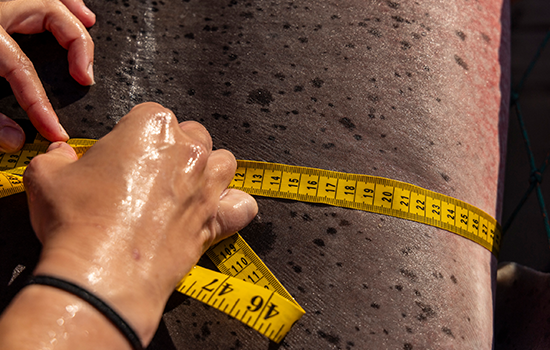
Sevengills, like most sharks, are ovoviviparous: they produce eggs, but the eggs hatch inside the mother’s body where the littermates grow to be at least a foot long before birth. A litter of sevengills typically includes 60 or more pups.
The ultrasound finds no babies this time.
For the last step, Schulte changes the direction of the water hose, and the shark’s stomach fills like a balloon. This is her research, so Schulte gets to hold the bucket that catches the vomit as it expels. This is how she’ll learn what this shark has eaten. The first burst goes straight into her rubber boots.
“We equate fear in the water with sharks,” Chapple said. “But so many other things are more dangerous — like driving through Portland.”
Reporters frequently call Chapple after biting incidents. He stresses that the ocean is not our environment. Even Michael Phelps or Katie Ledecky can’t compete with animals living there. We need to give sharks the same respect we’d give a grizzly bear at Yellowstone or a lion on the Serengeti.
Can we learn to temper fear with appreciation and awe?
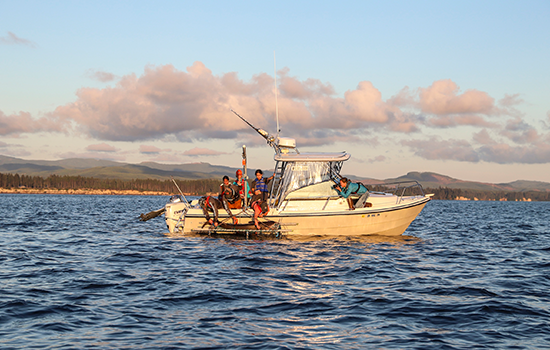
Chapple and his students go surfing, knowing sharks likely are nearby. If a great white is spotted, Chapple said, he’ll be the first to return to shore.
But here’s what really scares him: “My big fear is that we will miss the opportunity to understand how important sharks really are, to understand what an intact ecosystem is like.”
Over two days, we bring 11 sharks on board (one got away). The last is released in eight minutes flat.
Once the cradle is back in the water, most sharks vamoose. But one doesn’t move. Chapple speaks to her gently: “Remember you can swim.” She stirs. Another moment passes.
Then, silent and graceful as a dancer, she vanishes.



